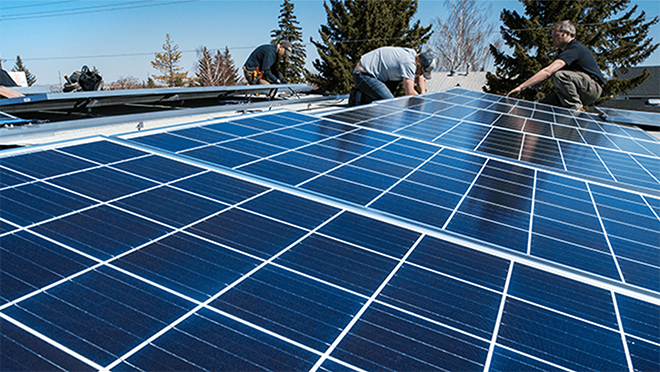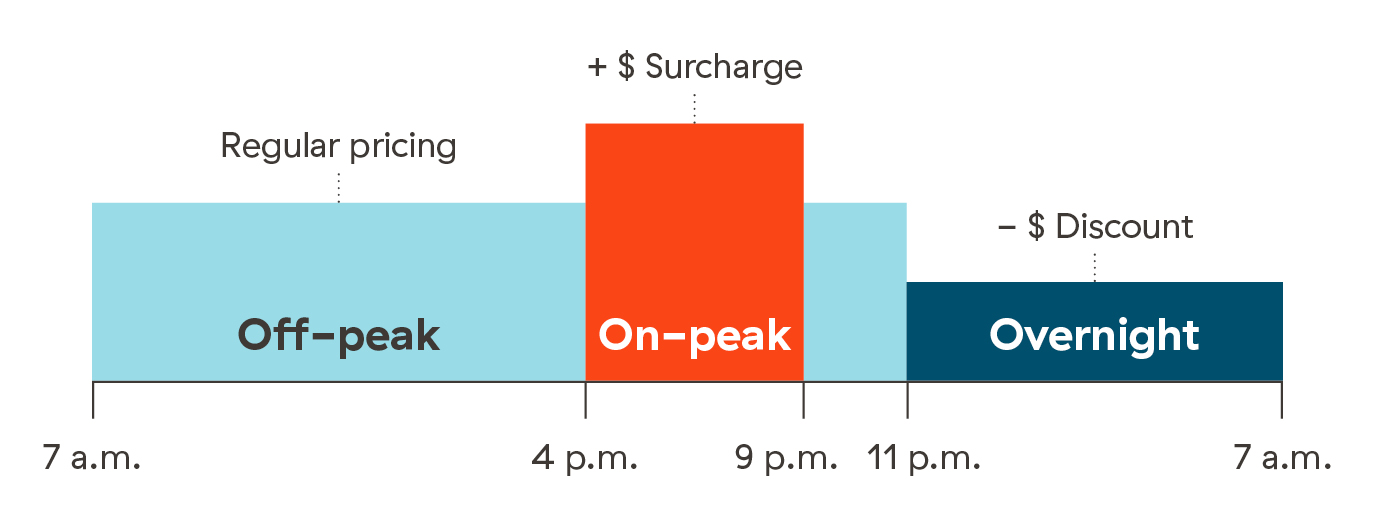For general self-generation and self-generation billing inquiries, please call us at 1 800 224 9376, or if you're outside the Lower Mainland, at 1 604 224 9376.
For questions on your self-generation application, please email us.

Our self-generation program – previously called net metering – is designed for those who want to reduce their electricity bills and gain energy independence by generating their own electricity. It allows you to power your home or business with your privately generated renewable energy, with the flexibility to rely on our grid if you need it.
As of January 2025, over 12,000 customers are participating in our self-generation program, with the majority using a solar photovoltaic (PV) system. Some customers install a battery to store excess energy they generate to use when they want to, or as backup energy during a power outage.
Reduce the payback period of your project by taking advantage of our rebates for solar panels and battery storage.
Self-generation is ideal for people looking to lower their electricity costs and achieve energy independence by producing their own power.
If your generation system (e.g., solar panels) produces more electricity than you need, you’ll earn generation credits to offset your future electricity use. If you still have generation credits left on the annual payout date, we’ll pay you for the excess electricity.
Work with your contractor to have your generation system designed, accepted for our self-generation program, and installed. Once it’s connected to the grid, you’ll be able to offset your electricity costs by generating your own power.
The self-generation program is open to residential and commercial customers. You can participate if your electricity generators meet the following eligibility criteria:
Want to join our self-generation program? Start by learning how applications work.
Use the same application to apply for rebates on eligible solar panels or battery storage.
Already applied? Check your application status or upload necessary documents. You’ll be prompted to log in first.
For recent regulatory activities and updates related to the self-generation (net metering) rate, see our current rate design activities.
* Or another source of clean or renewable energy generation as identified in the Clean Energy Act.
It can take about four weeks for your self-generation data to show in your MyHydro consumption graphs.
However, your first self-generation bill will show your self-generation data starting from the effective date that’s stated in your interconnection approval email.
The amount of electricity that you generate, as registered by your inverter's reader, won't match up to a data point on your BC Hydro bill. This is because the electricity you generate will first supply the electricity needs of your home or business. If you generate more than you need, excess generation will outflow to our grid and will be recorded on your bill as "outflow to the grid."
Your BC Hydro bill will also show the amount of additional electricity needed from us to supplement your home or business, which is labelled as "inflow from the grid."
If, over the course of one billing cycle, you generate more electricity than you consume, you’ll receive a generation credit in kWh that first applies to your current billing cycle. Any excess will then be carried over to your next bill. If you still have generation credits on your anniversary date (March 1), we’ll pay you for the excess electricity at the market price per kWh.
This payment comes in the form of a bill credit on your account. If you have multiple accounts with us and want to apply the bill credit to another one of your accounts, you can request a fund transfer by calling us at 1 800 224 9376.
Self-generation bill credits cover Energy Charges only. You’ll still need to pay any other charges that are part of your bill, such as the Basic Charge.
The program’s anniversary date – or, the annual payout date – is March 1. The date was selected as it allows for “solar” credits to accumulate over the sunny months which you can then use to manage your electricity costs throughout the winter, when British Columbians typically use more electricity.
If you’d like to change your anniversary date, you can make a one-time request by emailing us at self.generation@bchydro.com to set a new anniversary date for your account moving forward.
For those who still have generation credits on the anniversary date (March 1), the market price for annual surplus electricity is calculated on January 1 every year. It’s based on the daily average wholesale electricity prices in Mid-Columbia for the previous calendar year, converted to Canadian dollars using the average annual exchange rate from the Bank of Canada for that year.
Since the market price has been in place for our self-generation program, it has ranged from about three to ten cents per kWh, and has averaged six cents per kWh.
If your self-generation application was accepted before April 29, 2019, you’ll continue to receive annual payouts at the transitional energy price until April 30, 2024 in adherence with the B.C. Utilities Commission’s decision. Then, it’ll be the market price.
Yes, residential customers on the tiered or flat rate who are participating in the self-generation program can also opt into time-of-day pricing.
Time-of-day pricing is not available to commercial customers.
With time-of-day pricing, the price for electricity is highest during the evening and lowest overnight. Learn more.

Time-of-day pricing only applies to your inflow – the electricity you draw from our grid when you need it. It does not apply to your outflow back to our grid.
This means that:
By combining a generation system with time-of-day pricing, you can further reduce your electricity costs. We expect that the average residential self-generation customer with a solar panel system and electric heating would save about $52 per year on this rate plan, even without changing their daily habits.
Ways to save more:
Want to opt in to time-of-day pricing? Change your rate plan online.
If you're registered in Team Power Smart, you'll be unenrolled from this program if your self-generation application is approved. Any active Team Power Smart challenges will be cancelled.
Yes, even if it’s a small generation system, or one that won’t have any outflow to our grid, you need to apply and get approval prior to connecting your system to our grid.
This is a requirement from the Canadian Electrical Code, which stipulates that any customer who wants to connect a generating system to the electrical grid must meet their utility’s interconnection requirements and receive approval prior to connecting.
More importantly, it’s important for the safety of our electrical workers.
An unauthorized grid connection is any load-side generation source connected to our grid that we haven’t approved. This can include connections made without proper permits or those that don’t comply with safety standards.
Unauthorized grid connections pose significant safety hazards and legal implications. They can endanger both the property owner and the broader community by potentially causing electrical faults or fires.
We use various methods to detect unauthorized grid connections including routine inspections, monitoring systems, and reports from the community.
Unauthorized connections can lead to fines, service disconnection, and a service reconnection fee. If you have an unauthorized connection, you’re responsible for all associated expenses. However, if the service disconnection was made in error, you can discuss your situation with us to see if any exceptions apply.
If you discover that you have an unauthorized grid connection:
Contractors can:
You can find a contractor through the Canadian Renewable Energy Association member directory or the BC Sustainable Energy Directory.
The contractors listed in the directories provided are independent contractors and not affiliated with or employees of BC Hydro. We don't endorse the quality of work provided by these contractors or guarantee any of their services. It's your responsibility to interview and select a contractor that meets your needs, and we recommend that you get multiple quotes. You may select a contractor from these directories, or select your own contractor.
The average household uses approximately 10,000 kWh of electricity per year. A typical solar installation on a residential roof is seven kilowatts (kW) in size with 16 solar panels, which in B.C., generates 7,700 kWh of electricity per year.
Every project is different, but your contractor can assist you to better understand the estimated payback period of your project.
We're offering rebates on solar panels and energy storage systems for residential and business customers joining the self-generation program. Review the rebate offer details in the planning stage of your project to ensure that your property, equipment, and installation will qualify.
View solar panel and battery storage rebate information for:
For projects located in our non-integrated areas (NIAs), we strongly recommend waiting to purchase generating equipment until after the self-generation application is reviewed and accepted by us.
NIA systems use a variety of resources to support their electricity load, such as diesel, existing or proposed independent power producer (IPP) renewable generation, and intermittent energy via self-generation. That complexity requires us to perform a thorough technical review of each self-generation application received for projects located in an NIA, so we can ensure that we’ll be able to continue to provide reliable and cost-effective electricity to you.
Learn about rebates and how to apply in non-integrated areas.
For general self-generation and self-generation billing inquiries, please call us at 1 800 224 9376, or if you're outside the Lower Mainland, at 1 604 224 9376.
For questions on your self-generation application, please email us.